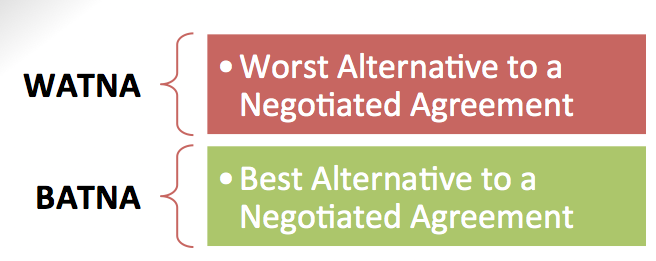In most negotiations, the parties are influenced by their assumptions about what they think are the alternatives to a negotiated agreement. Often the parties have an unrealistic idea of what these alternatives are, and they are unwilling to make concessions because they think they can do just as well without negotiating. If you do not have a clear idea of your WATNA (Worst Alternative to a Negotiated Agreement) and BATNA (Best Alternative to a Negotiated Agreement), you will negotiate poorly based on false notions about what you can expect without an agreement.

Often the parties in a negotiation need to decide how likely a particular outcome will be. If your WATNA is something that would be difficult for you to accept, but the likelihood of it happening is small, you might not feel compelled to give up much in negotiations. Realism is essential in this situation. If you could have the ideal situation, the “blue sky” scenario, negotiations would not be necessary. In order to focus on the negotiations with a sense of purpose, your WATNA is important. What is often referred to as the “worst case scenario” is something that any sensible person will think about before embarking on any initiative. What if it goes wrong? How will we deal with that? How you feel about the WATNA will dictate how flexible you need to be (and therefore will be) in negotiations.
The BATNA is almost more important than the WATNA. If you look at your situation in the absence of a negotiated agreement, and find it almost unthinkable, you will be pressed to enter negotiations in the hope of getting a satisfactory agreement. The word “satisfactory” is important here.
Is the WATNA better than satisfactory?
Is the BATNA worse?
Generally, people only enter into negotiations because they feel they have to. They arrive at this conclusion based on analysis of their WATNA and BATNA.
